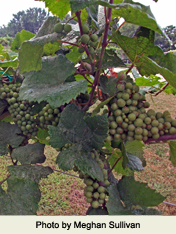Indiana
 The first vineyards cultivated for wine in Indiana were established by John James DuFour, an immigrant from Switzerland, near the beginning of the nineteenth century. DuFour searched for winegrowing possibilities along the banks of the Ohio River. In 1802 DuFour purchased 2,500 acres along the Indiana side of the Ohio River. Unlike his late 1700's vineyard of vinifera that did not survive, this venture saw plantings of the native Cape grape. The vineyard, in what is now Vevay, survived and gave impetus to the launch of the American wine Industry.
The first vineyards cultivated for wine in Indiana were established by John James DuFour, an immigrant from Switzerland, near the beginning of the nineteenth century. DuFour searched for winegrowing possibilities along the banks of the Ohio River. In 1802 DuFour purchased 2,500 acres along the Indiana side of the Ohio River. Unlike his late 1700's vineyard of vinifera that did not survive, this venture saw plantings of the native Cape grape. The vineyard, in what is now Vevay, survived and gave impetus to the launch of the American wine Industry.
The rise of patriotism as a result of the War of 1812 helped the new wine industry on both sides of the Ohio River. It was short lived, though, as agriculture prices fell in 1818, and the vineyards were replanted with other crops by 1830. However, wineries were scattered throughout the state until Prohibition. The resurgence in the Indiana wine industry began in 1970 and in 2017 the state had 92 wineries.
Many varieties grow in the state including Native American varieties, hybrids and traditional vinifera. However, it is the hybrid Traminette that has become the signature varietal grape in the state.
Indiana Wine Trails
Cardinal Flight Wine Trail
Indiana Uplands Wine Trail
Indy Wine Trail
Indiana Wine Trail
Hoosier Wine Trail
The Wineries of Indiana's North East Tour
There are two designated AVA's in Indiana: Indiana Uplands and the Ohio River Valley AVA. The Ohio River Valley AVA is one of the largest AVA's in the country also encompassing parts of West Virginia, Ohio and Kentucky. Vineyards located in this AVA are in the southern part of the state near the Ohio River.
Major Grape Varieties
White Varieties
Catawba
Seyval Blanc
Traminette
Vidal Blanc
Vignoles
Red Varieties
Baco Noir
Chambourcin
Marechal Foch
Noiret
Vineyard Acreage
600 acres
